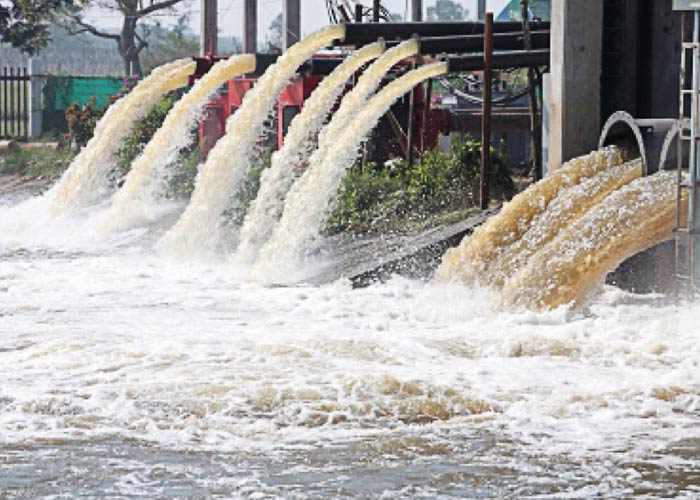The world is in peril. In the race of progress, we have made such a mess with nature that there has been an unbridled accumulation of greenhouse gases in the Earth’s atmosphere. This phenomenon is mainly responsible for increasing the global temperature as these gases stop heat from the Earth escaping into space.
According to an estimate, by the end of the century, the global temperature may rise more than 2 degrees Celsius, or 3.6 degrees Fahrenheit. Adverse effects on the environment due to carbon emissions include extreme heat during summers, extreme cold in winter, changes in monsoon, changes in temperature on the ground, rising sea level, melting of glaciers, untimely rains, droughts and floods.
The solution to this catastrophe lies in reduction in the carbon footprint of each and every person.
What is Carbon Footprint?
The name of carbon footprint came out of ecological footprint discussion. More than this is part of the Lifecycle Assessment (LCA). Carbon footprint means total carbon emissions by any single entity, person or product. The carbon footprint of a person, organization or object can be assessed on the basis of the emission of greenhouse gases such as carbon dioxide. In other words, carbon footprint is the total amount of carbon dioxide and other greenhouse gases that are excreted throughout the life cycle of any product or service.
How to Calculate Carbon Footprint?
Scientists have given the theory of carbon footprint to measure how a person has an impact on the environment in general. Almost all the work we do every day, or any of the tools we use, almost all habits of human being, including food to clothing, produce carbon dioxide (CO2) and cause carbon footprint. The carbon dioxide that we produce in a day, month or year is our carbon footprint.
A person’s carbon footprint is calculated in terms of major categories of consumption: housing, travel, food, products and services. The input per individual includes things like fuel use, calorie consumption, expenditure, distance, and spending behaviour. The appropriate emissions factor takes into account the relevant life cycle as much as possible. On an average, a city-dweller emits four tonnes of carbon dioxide in a year.
Carbon footprint estimates the climate change impact of each activity ranging from making a product, living a lifestyle or running a company. Broadly, a carbon footprint takes into account not just the CO2 emissions of a particular activity, but also emissions of all other greenhouse gases such as methane and nitrous oxide. Not excluded are other types of climate impacts such as vapour trails from aeroplanes.
By keeping personal carbon footprint to the minimum, the Earth can be saved from the outbreak of climate change.
Causes of Carbon Footprint
- Fossil Fuels
Carbon emissions and other greenhouse gases are caused by the burning of fossil fuels in the environment. In fact, any activity to fulfil a human need requires energy that emits carbon dioxide.
The electricity we use is mostly made from fossil fuels (such as coal, natural gas and oil). The more electricity we use, there is more fuel consumption for electricity production, leading to further increase in carbon dioxide.
Most of the things we use are made in factories by the use of non-renewable resources. These are sent to far-flung areas from the freight trains that again involve burning of fossil fuels.
- Modern Lifestyle
If we make a car account for each person on this planet, then the result will be more than seven billion cars – enough to create a catastrophe for mankind. Emission of carbon dioxide from petrol and diesel is estimated to be about 2.4 kg per litre. Apart from the pollution caused by the vehicles we run, there are many other reasons for the increase of carbon dioxide in the atmosphere. Our home, equipped with latest power-driven equipment, is another major source of carbon dioxide, which adds up to our total carbon footprint.
We live in an era where your image is evaluated on the basis of electronic equipment that you own, this assumption has increased the business of many equipment manufacturers around the world. Every electronic item such as a processor of a mobile handset adds to carbon dioxide in the air.
- Industrial Revolution
Whatever carbon dioxide was produced by humans before the industrial revolution was absorbed by surrounding forests and trees. Jungle, plants-trees absorb carbon dioxide and release oxygen back into the air.
With the beginning of the industrial era, fuel began to be used on a large-scale, leading to production of carbon dioxide in large quantities. At the same time, forests, which used to absorb carbon, were harvested in a big way for farming to feed the growing population. We have destroyed forests and trees to get wood, minerals, land, and build buildings. Today the situation is such that there is no sufficient amount of trees to absorb the amount of carbon dioxide produced in the environment.
- Food
The food we eat also contributes significantly to our carbon footprint. Especially when we eat processed foods, or we eat such foods that are not locally produced.
- Air Travel
Travelling by air is becoming more affordable with no-frills service provided by many airlines. The use of this mode of travel has increased rapidly; tier-2 and tier-3 cities are experiencing a large number of airports. But the emission of carbon dioxide from the aircraft is about 90 kg CO2 per hour.
Effects of Carbon Footprint
Carbon footprint is the measure of the amount of carbon emanated into the atmosphere by Human activities. Production of electricity and transportation are some of the major causes of carbon footprint. Carbon footprint left by human activities has a wide spread effect on the environment and is a matter of grave concern.
Some of the major effects of carbon footprint are described below:
1) Greenhouse Gases
Many human activities like electricity production and transportation results in the emission of green house gases like CO2 (Carbon di Oxide) resulting in the Greenhouse effect and an increase in Earth’s normal temperature. Transportation alone contributed to a 40% increase in the level of CO2, an important green house gas. And increase in the level of Green house gases result in the entrapment of heat on Earth, known as Green House effect. Many plastic production industries leave considerable amount of Carbon footprint, producing million of tons of Greenhouse gases into the Atmosphere.
2) Climate Change
Climate change is one of the major effects of leaving carbon footprint. Earth has a natural layer of Green house gases like, carbon di oxide, Methane, water vapor, Nitrous oxide, which help in maintaining Earth’s temperature by trapping UV rays from the Sun. The Greenhouse gases emanated from the factories or other transport related activities are most instrumental in changing the climate change as witnessed in the world today.
An increase in Green house gases results in an increase in the Green House effect, raising Earth’s surface temperature. A rise in the average temperature of Earth melts glaciers raising the oceanic level and having a disastrous effect on the environment. The Greenhouse gas emission by Human activities have resulted in melting glaciers, rising sea levels and more intense sea waves and the situation will continue to worsen for decades.
3) Marine Life Depletion
Carbon footprint generated by human activities has resulted in a considerable decrease in the Marine Life including sea Turtles, Dolphins, Whales etc. Ships of various sizes, whether used for fishing or transport leave some kind of footprint behind them, when sailing through deep waters. Sometimes huge sea liners are found to leave a trail of fuel and garbage in deep sea, which proves to be disastrous for life of marine animals.
Sea Turtles are documented to be incapacitated and dying, due to the ingestion of plastic bags into their digestive system, which they confuse with their natural food. Thousands of dead fishes are washed ashore because of the fuel that ships lay in deep sea, making the water practically un-breathable for the fishes.
4) Depletion of Natural Resources
Carbon footprint left by Human activities play a vital role in decreasing our natural resources and harming the environment. Every Human activity which leaves carbon foot print does its bit in the depletion of our natural resources. Activities like mining, results in erosion, formation of sink holes and contamination of soil and water, by the chemicals produced during the mining process. Apart from polluting soil and water it also results in deforestation, having an effect on ecological balance.
Other profit oriented activities by Humans like factories, too play a vital role in the depletion of natural resources by leaving considerable amount of carbon footprint into the environment. Tons of Chemical waste from our factories is washed into our water bodies and rivers, contaminating the water and rendering it useless to use. Apart from killing the aquatic life such chemical pollution has a disastrous effect on the life on land too. People are known to be suffering from a lifelong ailment or disease as a result of exposure to the contamination.
Tons of Green House gases and other pollutants like CO2 (Carbon di-oxide) and CO (Carbon Mono oxide) as a result of human activities like transportation and production result in a decrease in the air Quality Index, indicating a decreased level of oxygen in the air.
5) Habitat Destruction
Various Human Activities such as mining, factories, building of Roads and Highways lead to the destruction of natural habitat of humans and animals. Acres of forests are cleared, cutting down thousand of trees, for making roads or for setting up new factories. Lush green forests are replaced by concrete jungle marked with human activities.
Such habitat destruction of mammoth proportion results in the loss of life on Earth and a decrease in their natural resources. Habitat destruction is one of the vital effects of the carbon footprint left by Humans, leaving less space for the Humans and animals to survive, depleting their daily requirements for food and space. The destruction of their habitat leads animals towards human settlements, leading to human animal conflicts apart from constraining their resources.
How to Reduce Carbon Footprint/Solutions to Reduce Carbon Footprint
Protecting the environment is the responsibility of all of us. A draft on carbon emissions and greenhouse gases was introduced in the Kyoto Protocol. In the recent past, Delhi’s deteriorating air quality created a havoc, with the state government declaring restrictions on the number of cars through its odd-even scheme. Although it could bring some relief from air pollution, such decisions are of little value in the long-term.
Reduction in carbon emissions can be done through solar, wind power utilization and plantation, among other things. As a matter of fact, there are several ways to reduce greenhouse gases:
Small Steps, Big Impact
The car you use is not the only way to add to your carbon footprint because your whole lifestyle is a contributor. To decrease carbon dioxide in the atmosphere, you should use things judiciously, take as much walk as possible, use public transport, use recycled products, and eat locally produced things.
With several simple and practical steps you can successfully reduce your personal carbon footprint and become an agent of environmental change. If we can help a bit to save the Earth, our smallest efforts can make a big difference. Some of these efforts are as follows:
- Reduction in your carbon footprint can be brought from the economical use of electric power in the house. By using fluorescent or CFL bulbs, about 70 kg carbon dioxide can be reduced by a household in a year.
- Another way to reduce carbon dioxide is plantation. Plant more and more trees. A single tree absorbs one tonne of carbon dioxide in its lifetime.
- You can become ‘carbon-neutral’ that means you must plant as many trees as necessary to completely erase your carbon footprint. You should also take care of them so that they absorb the entire carbon dioxide emitted by you.
- Avoid short-distance travel in your own vehicle. Driving to work is probably the biggest contributor to your personal carbon footprint counting. If more people resort to using cars for personal travel, it will only result in traffic congestion and poor air quality.
- It is recommended that you reduce the use of your personal vehicle and use public transportation, while travelling to work.
- If your workplace is around your home then walk or cycle your way to it – an exercise that will help you stay fit too.
- Save energy as much as possible. An effective way to cut your carbon footprint is by using energy star-rated products. Star-rated devices save up to 15 percent power. This saving also reduces your extra expenses.
- Do not leave gadgets on standby mode as this way; they produce several kilos of carbon dioxide.
- We should go for electronic products with a lasting utility. As responsible citizens, we should stop changing our mobile phone handsets on some flimsy pretext to control our carbon footprint.
- Operate the washing machine only when there are sufficient numbers of clothes to wash.
- Install a much more water and energy efficient dishwasher, do not let your washer use electric heat or a fan to dry the dishes, just keep them in an open environment and let them air dry.
- Adopt recycling for glass, metals, plastic and paper, etc.
- Inflate your vehicle’s tyres properly and save up to 3 percent fuel per month.
- Do not waste food. It takes a lot of energy to prepare it. Eat fresh food instead of frozen food.
- Energy consumption can be reduced by using locally available foods.
- Eat organic food. In the US, the estimated 13 percent of greenhouse gas emissions result from production and transportation of food. There is no official figure for our country but considering its vastness, diversity and different tastes, the figure should be 8-10 percent. So, what can we do? Stop eating? Of course not. We should look for organic and locally manufactured foods. Organic farming is emerging on a large scale and we should support this cause as responsible citizens, and should buy products from such initiatives.
- Apart from this, reducing the consumption of red meat will also reduce your carbon footprint.
- Avoid canned, processed items. Your prudence can save the world.
- Use natural (renewable) energy whenever possible.
- Enabling solar panels can save your money and also bring down the carbon footprint of your home.
- Light coloured paints on the walls of the house are also helpful.
- We should avoid wastage of water and should try to optimize its consumption. Selecting energy-efficient faucet, toilet, dishwasher and washing machine goes a long way in reducing water wastage.
Carbon Trading: Another Way to Reduce Carbon Footprint
The case of carbon business is related to the reduction of greenhouse gases. The meaning of carbon trade is from the business of technology, which can reduce carbon emissions in fixed time horizon. In this trade, the countries, groups or companies involved will transfer the technology to each other under which carbon emissions can be controlled within a certain time frame.
The introduction of carbon business is subject to the fulfilment of certain requirements. Each country has a cap on the amount of carbon it is allowed to release. If a country or company fails to meet the low emissions target, then there is a provision for imposing penalties on it, as in England and other European countries.
According to this trade theory, the developed countries that have higher carbon emissions can be free from the responsibility of reducing the emissions of greenhouse gases, if they purchase the right to release more carbon dioxide into the atmosphere from countries that have lower carbon emissions. Under this arrangement, the former financially fund the environmental schemes of their poorer counterparts.
The country which easily achieves the emission standards determined for it can obtain surplus pollution standard certificates. It can sell its pollution standard certificates to other areas which have not been able to achieve the carbon emission standards.
According to the World Bank report, India’s share in world carbon trade is possible up to 10 percent, from which it will receive $ 100 million per year. Under the program of the United Nations, 12 firms of India have been permitted to do carbon trading. This decision has been made on the basis of decisions taken in the Conference on Climate Change.
The direct solution to this problem is that money is provided for the cultivation of trees on vacant lands. According to an estimate, billions can be earned from carbon business; India can make a lot of money by planting trees on millions of hectares of vacant lying land.
From this trade, on the one hand, the development of forests will provide protection to wild animals while on the other hand residents will get wood and other types of forest products.
As part of the UNECCC and Bali Action Plan, India has taken several steps to reduce emissions under the campaign against climate change in the interest of its energy security and sustainable development.
Similarly, the individual companies that pollute less can sell their unused pollution rights to companies that pollute more. Thus, companies are provided a financial incentive to pollute less.







